Etchings of towns, castles and scenery
from Scotland in the early 19th century

Eglinton Castle
"Although this part of the country cannot boast of the rude magnificence and picturesque grandeur of the Highlands, yet its milder features and more polished beauties are highly deserving of attention; and the noble owners of Eglinton Castle and its domain have succeeded in adding to the beauties of this spot, and to the comfort of its inhabitants. This Castle is in the parish of Kilwinning,in the county of Ayr, and was built by the present earl.
The remains of the old castle, which General Monk formerly garrisoned for sometime, were destroyed, when this was erected. The architect, Mr.Patterson, has happily succeeded in the "adaptation of Gothic outline to the details of modern accommodation, "a style not unfrequent in North Britain: and while the external part carries the mind of the spectator to those ancient times, when strength and security were the objects in country residences, the comforts and elegance of the internal structure are suited to the most civilized and polished age."
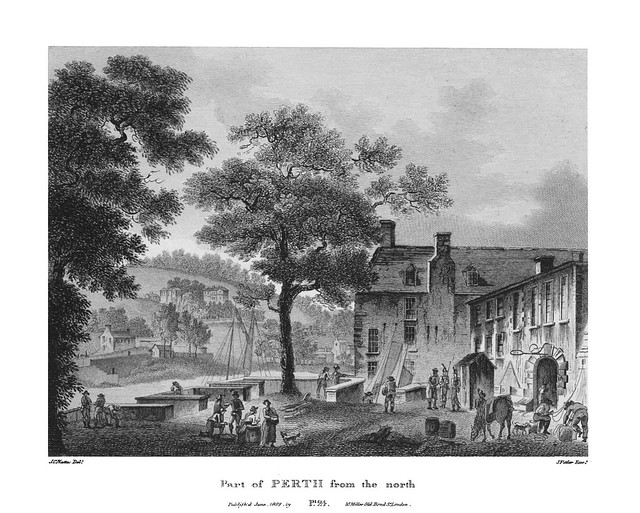
Part of Perth from the North
"No spot in Scotland claims more attention from the antiquary, the historian, and the admirer of fine scenery, than Perth. In former times it was the seat of supreme courts, the residence of many powerful feudal lords, and the seat of various religious establishments. Numerous vestiges of these antiquities strike the eye in every part: amongst the rest must be particularly noticed the palace of Gowrie, so celebrated for the tragical, yet mysterious, attempt against the life of James VI. This palace, the back of which is seen in the present Plate, remains entire, and is now converted into barracks for a company of artillery. [..]
Numerous vestiges of these antiquities strike the eye in every part: amongst the rest must be particularly noticed the palace of Gowrie, so celebrated for the tragical, yet mysterious, attempt against the life of James VI. This palace, the back of which is seen in the present Plate, remains entire, and is now converted into barracks for a company of artillery. [..]
The consequences of this extensive commerce are an increased population from fourteen to twenty thousand, an opulence, which shews itself at the hospitable boards of the inhabitants, in the erection of handsome buildings, and the decoration and high cultivation of the surrounding country. Among the rest is the handsome residence, as seen in the Plate, called Bellwood, the seat of Mr. Young, whose enterprising spirit and well-directed industry have procured a large fortune for himself, and an improved trade for the town at large."
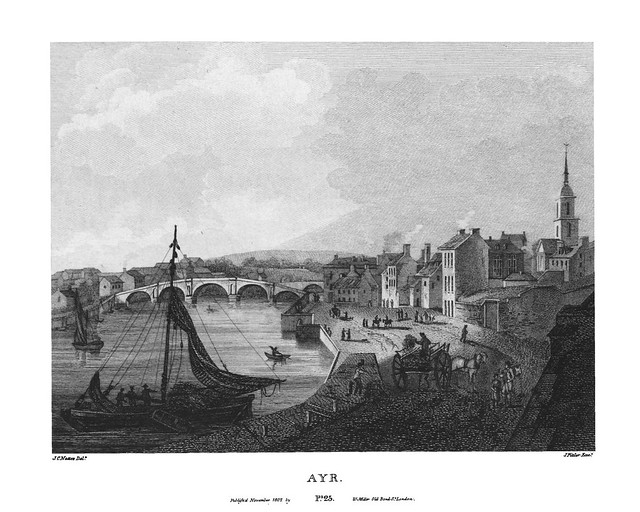
Ayr
"The county of Ayr lies in the south-western part of Scotland, and is bounded on the west by the Irish Channel. The present Plate exhibits a view of its chief town, which bears the same name. This place is of no very considerable extent, but it is pleasantly situated quite on the coast, and has the advantage also of being watered by two rivers, which discharge themselves at or near this place into the Irish Channel. One, called the Ayr, whence probably both the county and this town took their names, runs immediately through the town, and is seen in this view; the other, the Doon, runs nearly parallel, but a little more to the south, and at a short distance from the town.
On entering this place the most striking objects are the new and the auld bridges, which Burns has personified with so much successful humour. The former is handsome and convenient, and was built from a plan of Adams's, while the auld brig, if we may believe the poet, is so narrow and bad, that 'twa wheel-barrows tremble, when they meet'. These bridges connect the old Borough with the New Town. The population of Ayr is not very large, the whole parish, which is of more extent than the town, contains only between four and five thousand, and the town itself rather more than three thousand inhabitants. The church is rather a handsome structure. It was built in the year 1654, and is kept in repair at the expense of the magistrates. The markets are well supplied, and not unreasonable; and coals, which are found in the neighbourhood, and consequently rather cheap, are of great comfort, especially to the poorer class. The country round Ayr is flat, but is much improved from the plantations and seats in the neighbourhood. The soil also is rich and productive. This view was taken in 1801."
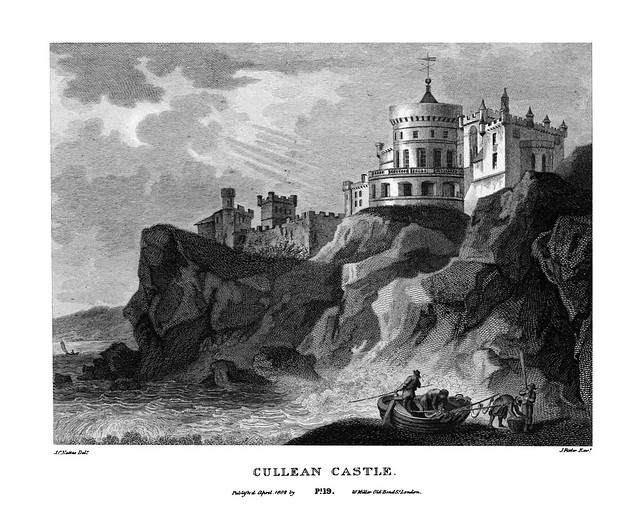
Cullean Castle
"Few buildings can lay claim to a situation so bold and picturesque, and yet so beautiful, as Cullean Castle. It stands on a rock, that projects into the sea, while its sides, almost perpendicular, rise about one hundred feet from the surface of the water. It is perhaps the most striking situation in the county of Ayr. This Castle was built so late as the year 1777, after the design of Mr. Robert Adams, and is well executed. Its outline is happily varied by the roundness of some parts, and the angular projections of others; and it is upon the whole a fine specimen of modern gothic.
The view from the principal apartments towards the sea is extremely grand. It embraces the whole of the firth of Clyde, and the bold and mountainous isle of Arran; while towards the left is seen an opening into the Atlantic between the mull of Kintyre and the distant coast of Ireland. This surface of water is also still further diversified by the singular rock, called Ailsa Craig, which rises almost perpendicularly above nine hundred feet; between which and the walls of the Castle most vessels, that navigate the Clyde, pass."
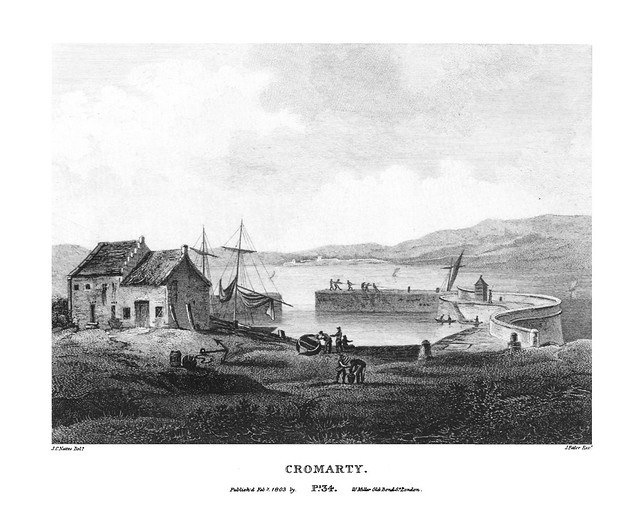
Cromarty
"The county, which bears the same name, and of which this is the principal town, is in the northern part of Scotland, and on the east coast. The whole county is almost surrounded by the Moray Firth, and that of Cromarty. Where it joins the land, it is bordered by the county of Ross. The Firth of Cromarty is both picturesque and singular: the entrance to it, which can only be seen to advantage by going out some way in a boat, seems formed by a sudden opening between two rocky promontories, about a mile asunder, called the Sutors of Cromarty. [..]
The town of Cromarty, with its harbour, is situated on the south side, and consists for the most part of new built houses, but is not very extensive, while numerous houses are scattered all round the bay. [..] This view was taken from the side of the bay near the pier, which is seen in the foreground, in 1799."
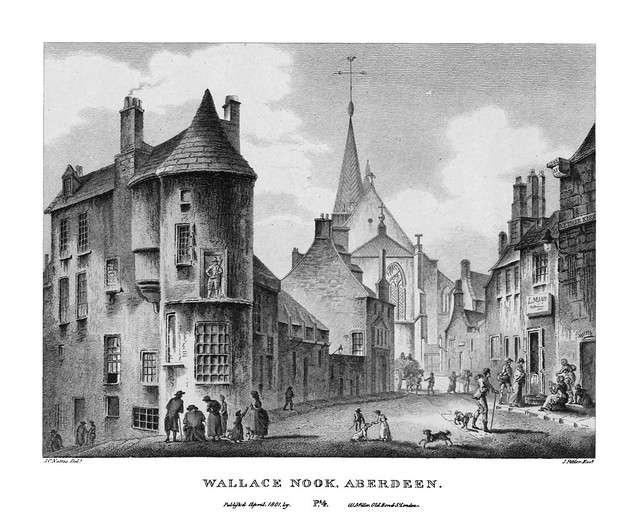
Wallace Nook, Aberdeen
"This Metropolis, including the Old and New Town, of the northern division of Scotland, is situated between the influx of the Don and the Dee into the German Ocean. There are two parishes; Old Machar, now also called Old Aberdeen, or the Old Town Parish, and St. Nicholas, or New Aberdeen. The first is the most extensive, though the New Town is much the larger. The different buildings, which are scattered, either for trade or residence, over both the parishes, and the fine inequalities of the surface, render the views highly interesting and beautiful, especially towards the west, where the horizon is terminated by the Grampian Hills. [..]
For what reason the particular spot in the New Town, whence this view is taken, is called Wallace Nook is now unknown. No record at present exists, and it must depend simply on traditional supposition. [..] This view, however, is extremely picturesque, and not unlike some of the towns in Italy, to which the style and masses of building in the north are often very similar. The church of St. Nicholas appears in the centre, and, with the other parts, forms a most interesting picture."
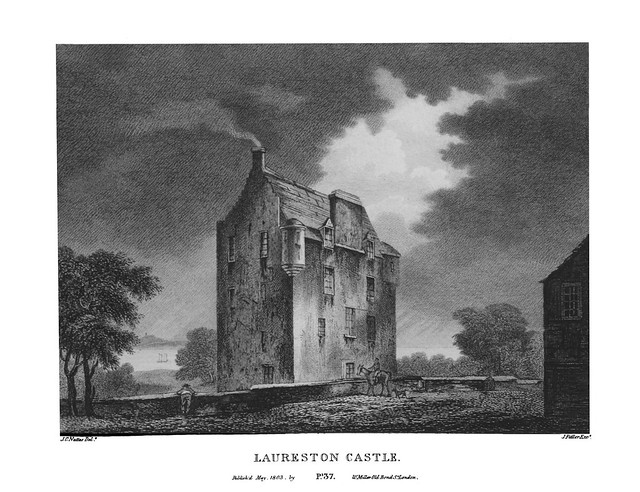
Lauriston Castle
"The old Castle is said to have been built in the eleventh century. The two towers, and part of its immensely thick walls, still remain, and are incorporated with some modern improvements the present proprietor, who has thrown a fine bridge of one arch over the den, and connected the castle with some of the finest grounds and most picturesque part of the den. This spot gave birth to that celebrated character, John Law, Comptroller General of Finances in the court of France, whose various plans and speculations are so admirably detailed by Adam Smith in his Wealth of Nations. The family of the Strattons, who possessed this estate several centuries, were Lairds of Lauriston, and so attached to this place, that whenever they settled in other parts of Scotland, they changed the name of the place to that of Lauriston. This view was taken in 1799."
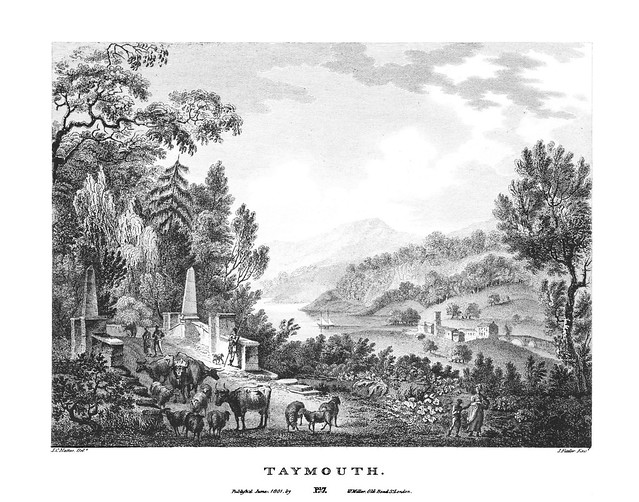
Taymouth
"No country is more diversified, adorned, and benefited, by the different lochs, that are scattered over its surface, than Scotland; in almost every part of which they produce great variety of scenery, form a beautiful and picturesque series of views, and afford a plentiful and cheap article of food. Loch Tay, situated in the midst of the fertile and rich county of Perth, and which forms the centre of the present plate, is deficient in none of these. [..]
The bridge, which is seen on the foreground to the left, was built by Lord Breadalbane over a brook, which will amply repay the picturesque traveller for the trouble of tracing it to its source, by a variety of beautiful scenery. The road over it is a public one, although it passes through his Lordship's park, and either by that, or the one on the opposite side of the loch, is a most delightful ride to Killin, skirting the water almost the whole way. To the right in this View, which was taken in September 1800, is seen the bridge, inn, and church of Kenmore; and beyond the last is part of the little wooded island."

Gordon Castle
"The parish of Bellie, in the county of Bamff, in which Gordon Castle is situated, extends near six miles from the north to the south, and about four from east to west. It is bounded on the north by the Murray Firth, and on the west by the Spey River. The banks of this river, or rather of the vale, in which the river runs, are of great height, and of various extent in width; and include a rich and beautiful surface of ground. On the south of this fine level stands the magnificent building, Gordon Castle, the pride of Scotland, with a front extending five hundred and fifty eight feet. Of this view the etching, here given, is superior to, and renders useless, all description. It is one of the noblest palaces in North Britain, and is almost the entire work of the present Duke, if we except the tower in the centre. [..]
In forming the present park and landscape about the Castle, vast sums have been expended in draining the ground, as it was formerly an entire bog, except the site of the castle itself; and the ferry-boat over the Spey is still called the Boat of the Bog. The old castle, of which there is a curious plate in Pennant**, was a fine ancient building. The tower is the only part that appears in the front of this etching, which was taken in October 1799."**Thomas Pennant [BBC bio]: 'A Tour in Scotland' 1769+, Web Archive || Amazon.
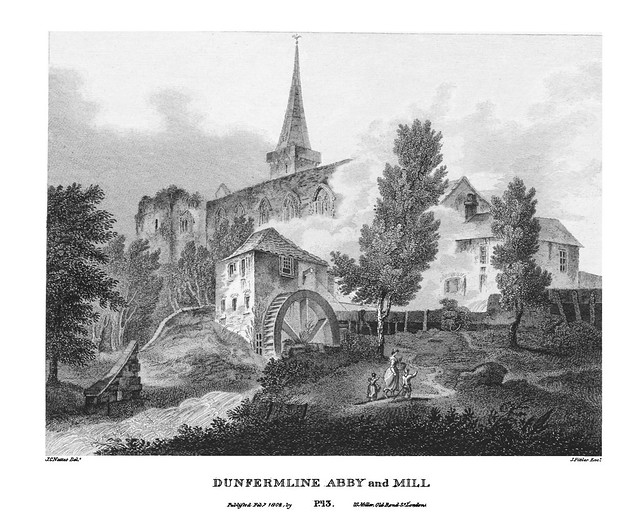
Dunfermline Abby and Mill
"The town of Dunfermline, in, or rather close to, which the ruins of this Abbey remain, is in the county of Fife, and at a short distance from Edinburgh. It became, at a very early period, a residence for the Scottish monarchs, and Malcolm III, surnamed Canmore, resided in a tower, or castle, built on a peninsulated hill in the glen. A palace was afterwards erected a little to the south-east of the town, in a situation truly romantic. The walls of this are still standing, and tradition continues to point out the chimney of the apartment, where the unfortunate Charles I. was born. [..]
This view, which was made in 1799, is taken from a field on the Pittencrief side, and with the ruins, partly obscured by the smoke, arising from the drying-house of the mill in front, with the water running from the wheel, forms a most pleasing scene. Almost every corn-mill in Scotland has a kiln or drying-house, attached to it, where the corn is constantly dried, previous to its being ground."
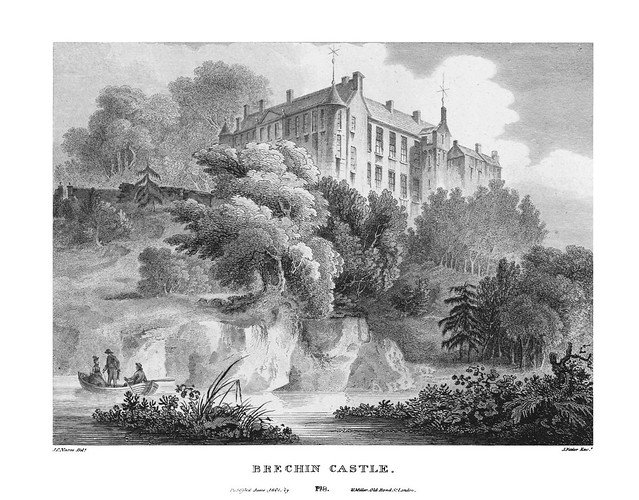
Brechin Castle
"The town, or city, of Brechin, as the name denotes, is built on a hill; Brunichaun, in the Gaelic language, meaning the top of a declivity. Perhaps, however, it is derived from Breaichuain, a view of the firth, as from the east you have a fine view of the bay of Montrose, which bounds the county of Angus on that side, at the distance of about eight miles. It is of very considerable antiquity, and was formerly a bishop's see, possessing a cathedral, and also a convent. [..]
Nothing can be more picturesque than the view of this castle, as given in this plate; the drawing of which was taken in September 1800. The Usk running along the foreground, with its opposite rocky bank, partially naked, and partially covered with trees and brush-wood, and the whole crowned with the castellated building, forms a scene at once beautiful and grand.
Of the ancient castle of Brechin no vestige remains. In 1303 it underwent a long siege, and was gallantly defended, though attacked by a powerful army under Edward the First: and notwithstanding all the efforts of that potent prince, the brave governor, Sir Thomas Maule, held out for twenty days; at the end of which time he was slain by a stone, thrown from an engine, on the 20th of August, when the place instantly surrendered."
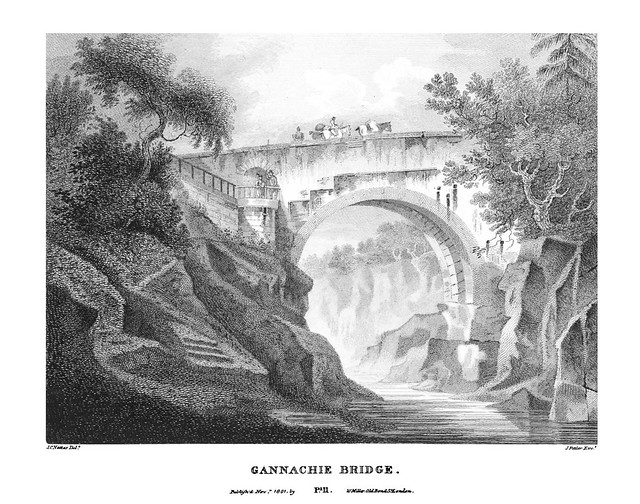
Gannachie Bridge
"Over the river Northesk, which runs through the county of Kincardine, and in the parish of Fettercairn, is thrown this singular arch {1732}. This river runs through the grounds of Lord Adam Gordon, who has built an elegant modern house on his estate in this parish; and has formed, with peculiar taste, a most beautiful and romantic walk along its rocky banks. This bridge, which consists of one arch, is fifty-two feet over, stands on two tremendous rocks, and is justly admired as a singular curiosity, both in regard to its situation and construction. Beneath the bridge is a vast abyss, near fifty feet in depth, through which the river sometimes rushes with overwhelming violence. Its rocky channel, with its lofty and precipitous sides, fringed with wood, forms a series of picturesque and beautiful scenery both above and below the bridge."
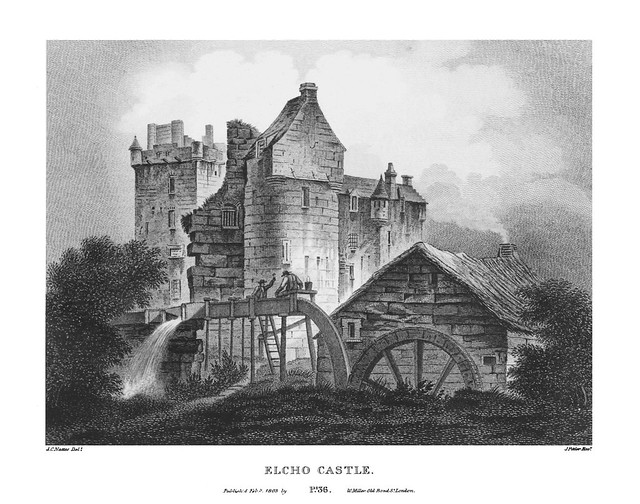
Elcho Castle
"We have again to notice another specimen of Gothic architecture in the fertile and beautiful county of Perth, the garden of Scotland. [..]
Throughout Scotland every mill is accompanied with a drying-house, for the purpose of drying and hardening the corn, in order that it may grind the better into meal. The smoke, which almost constantly issues from this kind of kiln, being carried by the wind over different parts of the buildings or scenery, tends very much to increase the picturesque effect of views, where these mills are found.
On the opposite side of the Castle the scenery is very beautiful. The views are along the north side of the Tay, over a tract of land called the 'Carse of Gowry', and so very fertile as to be esteemed the granary of Scotland. This drawing was made in the year 1800."
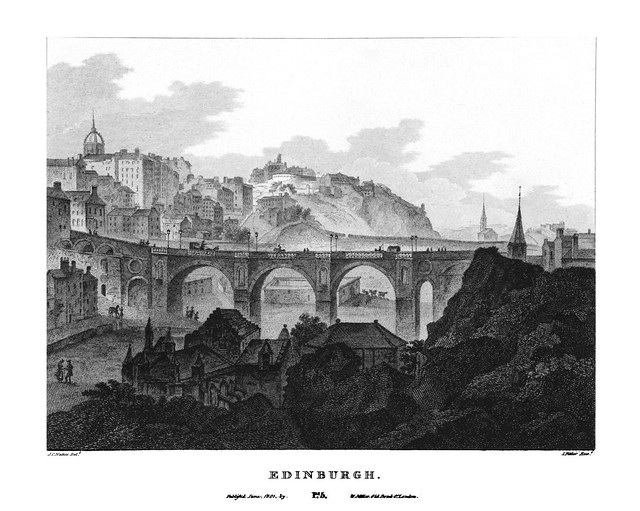
Edinburgh
"Within the limits, to which we are confined, it is impossible to give any thing like a minute description of the city of Edinburgh, the ' Queen of the North.' [..]
This View, which was taken in July 1799, from the Calton Hill, comprises the North Bridge, through the arches of which is seen the slaughter-house; the ruins of an old Abbey below, in the foreground, with the crown-like tower of St. Giles farther distant to the left; the castle towards the centre, and the West Church in the distant horizon."
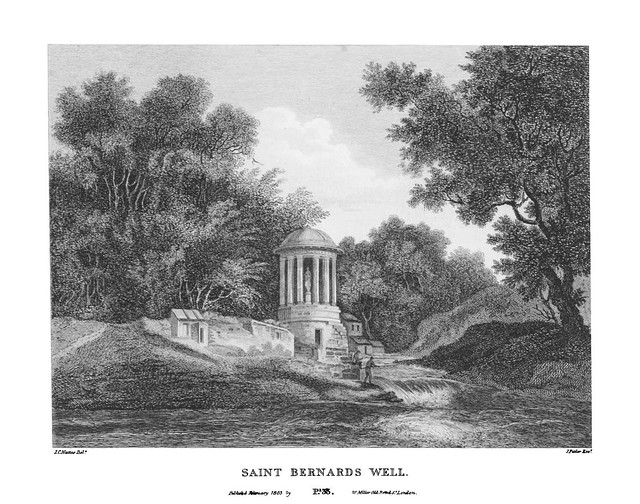
St Bernards Well
"The beautiful little Temple, erected on the spot, known by the name of Saint Bernard's Well, owes its existence to that benevolent Nobleman, the late Lord Gardenstone. This building, which is from a design of Mr. Nasmyth, is not unsimilar to the Sibyls Temple at Tivoli, and which the artist probably had in his recollection, when he formed this plan. It is circular and open, with a dome supported by pillars of the Doric order. The Temple is dedicated to the goddess of Health, but the statue of Hygeia, which stands in the centre, is infinitely too large for the building. [..]
The water of this Well issues from a rock close to Leith water, into which it runs a little above Stockbridge. It is of a sulphurous quality, and slightly impregnated with iron. It has been found of use in many disorders, and being situated amidst some very beautiful scenery, and at a very short distance from Edinburgh, was at one time visited by almost all its inhabitants; but like most things of the same nature, fashion and whim have, at different periods, exalted it above and sunk it below its true value. The scenery about it is most beautiful, though the prospect is confined. The river winds round a rocky point, or dashes over a stony bottom, while the walk, following its course with artless irregularity, presents to the view sometimes bare cliffs, and at others rich woody slopes. This view was made in 1799."
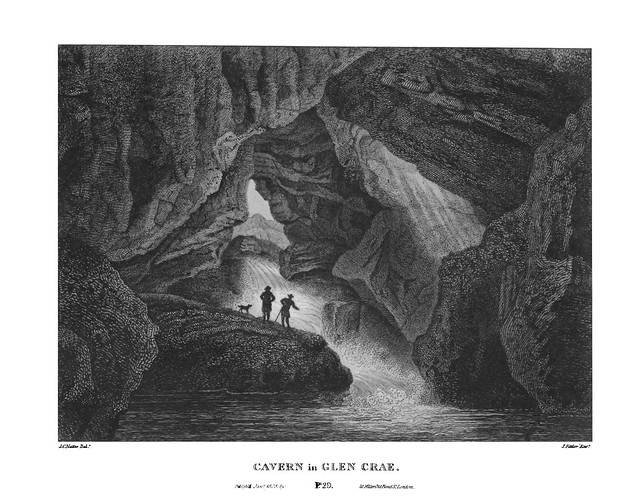
Cavern in Glen Crae
"The country in the vicinity of this Cavern {in Argyleshire}, is perhaps as tremendously grand as any part of Scotland. [..]
From the appearance of the stream, few people are induced to quit the road to examine it: yet it affords a remarkable instance of such romantic scenery, as sometimes occurs unexpectedly, in Scotland, among objects, which do not seem to promise it. The rocks, lying in its course, consist of fragments, fantastic in form, and vast in magnitude, torn from the sides of the adjoining mountains, and piled confusedly together. Upon a near approach you find, that the water, forcing its way amongst them, has increased their picturesqueness by its powerful operation. In one part it rushes violently along, tumbling over them in cascades; in another it is only heard to growl in an inaccessible dungeon below; and in several places it has formed the most extraordinary caverns and excavations.
One of these (the subject of the present plate) might have passed for the grotto of a Naiad, designed with peculiar fancy. At one end the sun-beams, admitted through different openings, played upon the water; at the other a small cascade glittered in the gloom: the sides were wrought into various odd forms by the whirlpools; and in one part a natural chair was scooped out of the rock. This view was made in 1799."
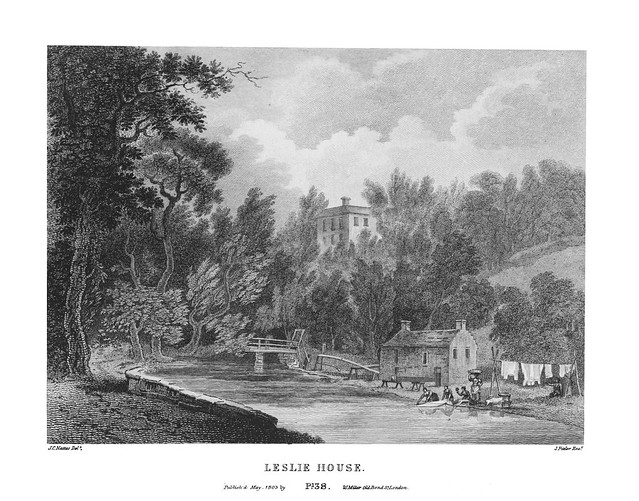
Leslie House
"Leslie House, which is in the parish of the same name in Fifeshire, was originally a most magnificent seat, built by the Duke of Rothes, round a court similar to the abbey of Holyroodhouse, with a gallery of rather greater extent, and ornamented on one side with a collection of the portraits of the Rothes family, and on the other with those of the particular friends and contemporaries of the founder. [..]
The scenery upon the banks of the Leven, which is seen in the foreground, is very beautiful: and from the point of view, where this drawing was made, the laundry on the opposite bank forms a very picturesque object. The grounds are well wooded, and the approach to the house is ornamented with a fine avenue of elms. This view was made in 1799."
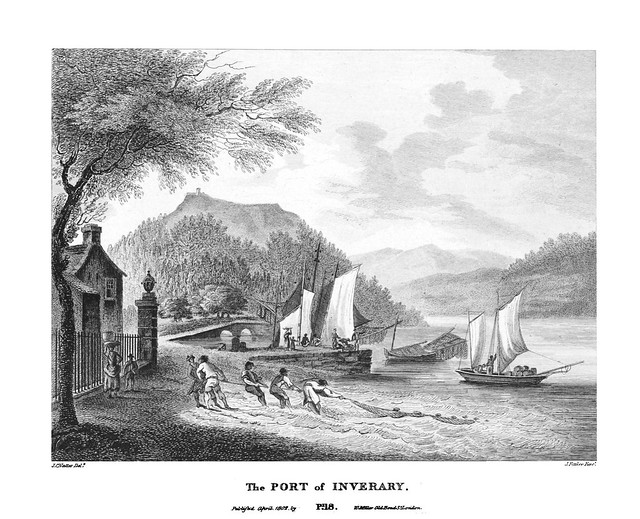
The Port of Inverary
"This town is the capital of the county of Argyle, which gives the title of Duke to the Campbell family. The old town is now nearly deserted, and the inhabitants have removed to the new one, built mostly at the expense of the Duke of Argyle, whose castle stands at a short distance from the town. [..]
The environs of the town are beautiful in the extreme; and the top of Dun-y-coich, which is seen with its solitary tower to the left of the distance, from the insulated site of the hill, though not more than seven hundred and fifty feet high, embraces a most extensive view of Loch Fyne and the surrounding mountainous country. This drawing was made 1799."
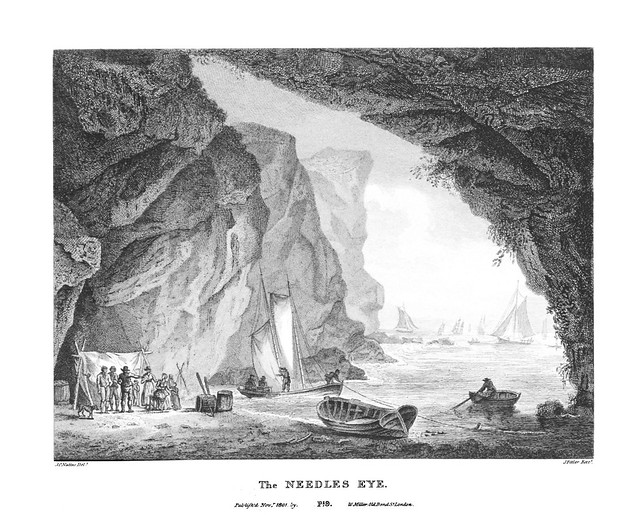
The Needles Eye of Troup
"No part of the northern coast of Scotland, full as it is of romantic and wild scenery, affords bolder, or more picturesque, views than the parish of Gamrie, in which this Cavern is situated. It is in the county of Bamff, the northern limits of which are circumscribed by that part of the sea, called the Murray Firth. This parish extends above nine miles along the coast, which consists of an unbroken chain of stupendous rocks, in many places near two hundred yards above the sea, and almost perpendicular. Among a variety of other Caverns, with which this shore abounds, is the remarkable one, chosen for the subject of the present Plate. [..]
Nothing of a similar nature can be upon a grander scale; and the effect, as it strikes a person, who has come through from the southern entrance, when from the narrow passage he suddenly bursts upon this expanded cavern with the light breaking upon the opposite rocks, and the sea in front, is truly wonderful. This view is taken from the inside of the cavern near the entrance, and shews the rocks leading towards Gamrie Head, with a part of the Murray Firth towards the west. The cavern, as well as the adjoining coast and land, is on the Gardener estate. This view was taken in 1799."
'Scotia Depicta; or, the Antiquities, Castles, Public Buildings, Noblemen and Gentlemen's Seats, Cities, Towns, and Picturesque Scenery of Scotland' (1804), contains 48 prints, etched by James Fittler after sketches by John Claude Nattes, and is newly online in its entirety, in a couple of formats, courtesy of the National Library of Scotland. [Thumbnail page images]
The images above were all cropped out of custom pdf files I downloaded simply to make it easier for myself. They appear to be acetate scans or similar; I think they provide a very adequate overview. But it's nevertheless worth your while visiting the source document online because the NLS has actual photographs of the album pages within a tiled zoom frame. The quotes above come from the page transcripts, also kindly provided by NLS.
The alert that this book had been recently digitised came from what is my current favourite email subscription: the monthly newsletter from the National Library of Scotland. It's short, sweet and always contains something of interest.
The British Museum has a set of these etchings online too. Search on 'Scotia Depicta' from this page --> the images aren't as good quality as those at the NLS, but if you mouseover the names of the artists you'll get short biographies.
'Scotia Depicta' for nearly $5000 - not sure if the listing is current or old.
Scotland at Googlemaps.



















1 comment :
The details in these drawings are awesome!
Post a Comment
Comments are all moderated so don't waste your time spamming: they will never show up.
If you include ANY links that aren't pertinent to the blog post or discussion they will be deleted and a rash will break out in your underwear.
Also: please play the ball and not the person.
Note: only a member of this blog may post a comment.